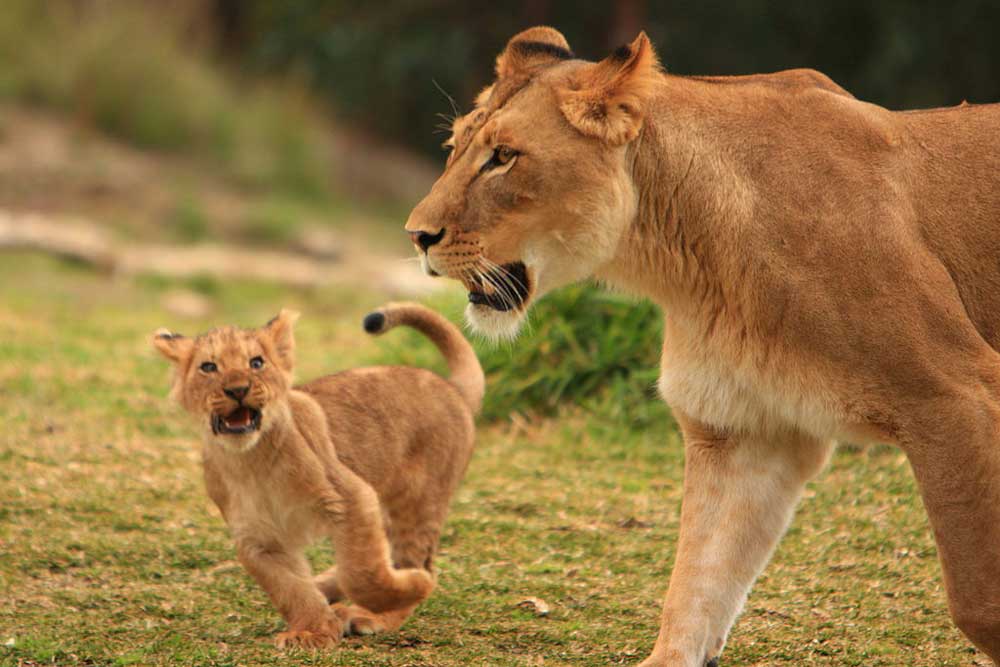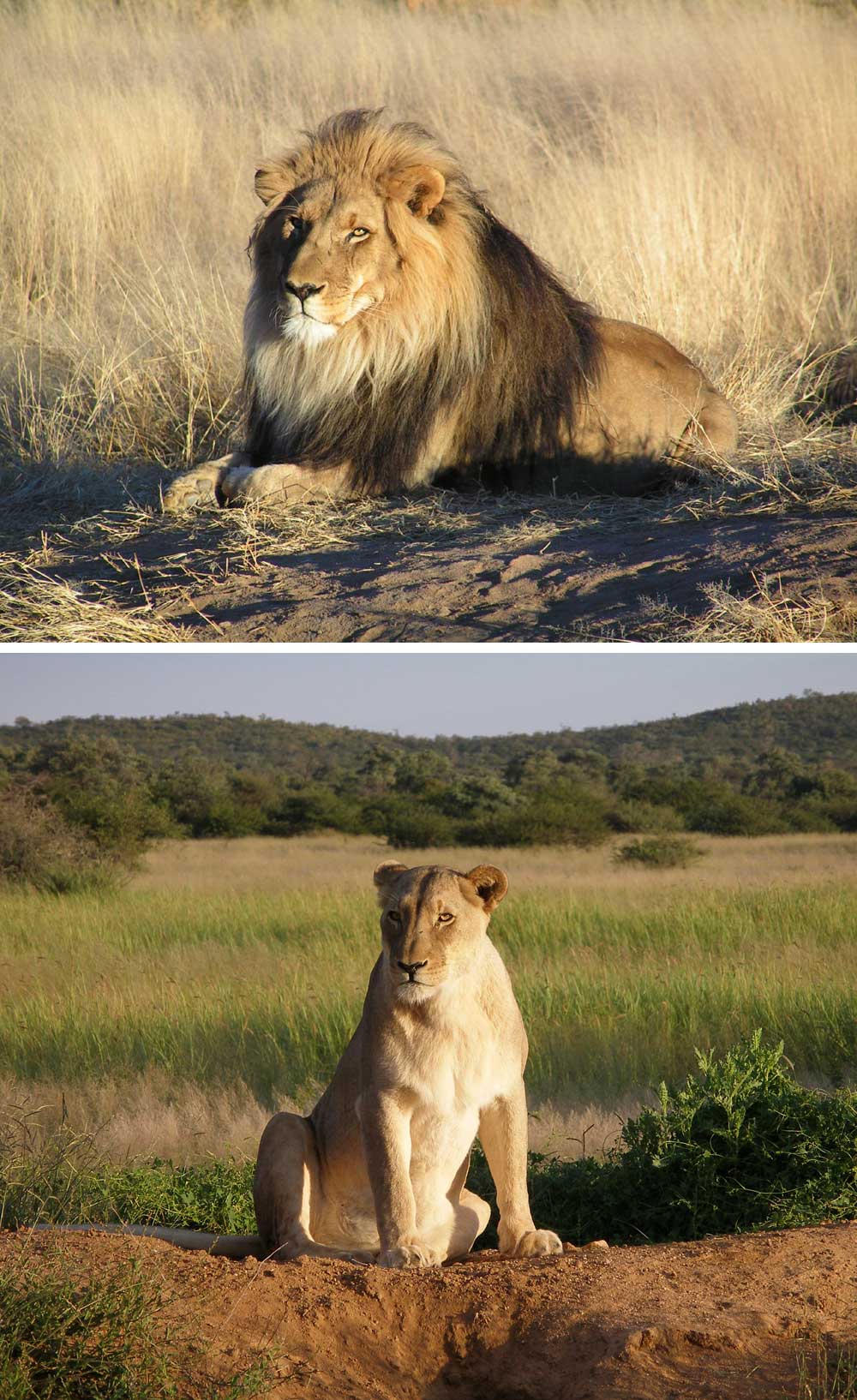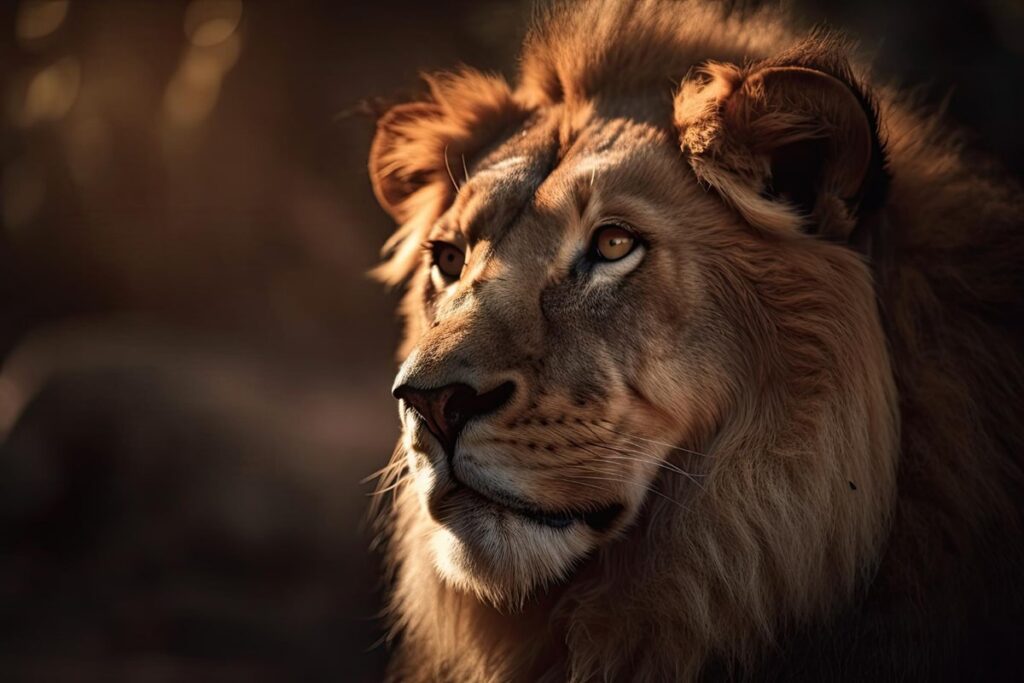- The tiger: The tiger is the lion’s closest relative. The lion is the second largest of all felines after the tiger
- Species: There are 8 recognized subspecies of the lion (Panthera leo), of which 1 is extinct, 6 live in Africa and 1 in India. However, they are often simply divided into ‘African lions’ and ‘Asiatic lions’
- Power: Lions can run up to 80 km/h over short distances and jump up to 11 m in one leap!
- Social animals: Of all the larger felines, lions are considered to be the only ones that are truly social. They live together in prides of around 10-15 members
- Size: Adult male lions are typically 3 m long and weigh around 150 – 250 kg, while female lions are around 2.7 m long and weigh 120 – 180 kg. The tail usually adds between 60 cm and 1 m to the overall length of the animals. Shoulder height is 1 – 1.2 meters. Asiatic lions are generally slightly smaller than African lions
- Lion roar: A lion’s roar can be heard up to 8 km away and is the loudest of all feline
- King of the jungle: Although lions are sometimes called the ‘King of the Jungle’, they only live in plains and open grasslands
- Communication: Lions communicate through a series of highly developed behaviors and expressive movements. They rub heads and lick each other, as well as use sounds such as growling, meowing, hissing, etc.
- Occurrence: Lions are currently found in 2 places in the world: Sub-Saharan Africa and India. However, Asiatic lions are only found in the Sasan-Gir National Park, where they are highly endangered (there are about 400 left)
- Historical distribution: Until the Pleistocene epoch around 10,000 years ago, the lion was the most widespread large terrestrial mammal after humans. At that time, they were found in most of Africa, the Middle East, southern Asia and parts of Europe. In the Americas, they were found from the northern part of Canada all the way down to Peru

Fact: Lionesses are very caring mothers who raise their cubs together and are happy to take in neglected or orphaned cubs
Facts about the lion hunt
- Division of labor: In the lion pride, female lions primarily hunt and male lions defend the pride and its territory. Despite this division of labor, it’s almost always the males who eat first
- Collaboration: When females hunt, they almost always do so in a group because they can catch prey they wouldn’t be able to catch on their own
- Prey: Lions primarily hunt larger prey such as zebras and wildebeest. They may also steal prey from other predators such as hyenas and leopards
- Sleep: A lion typically sleeps and rests for 16-20 hours per day. This is because lions have few sweat glands and therefore save their energy for the evening and night, when it’s cooler and more appropriate for hunting and being active in general
- Night vision: Lions have much better night vision than humans, being 6 times more sensitive to light than us. This gives them a distinct advantage when hunting at night
- Nutritional needs: A female lion needs around 5 kg of meat per day, whereas a male lion needs 7 kg or more

Until about 10,000 years ago, the lion was the second most common large land mammal after humans. At that time, lions were found in most of Africa, the Middle East, southern Asia and some parts of Europe. In the Americas, lions were found from the northern part of Canada all the way down to Peru
The life of a lion
- Pack: Lion prides are characterized by pack mentality (as seen in wolves, for example) and it’s usually the females that lead the pride
- Caring mothers: Lionesses are extremely caring mothers who will even take in neglected or orphaned cubs and allow them to nurse, eat, etc. so they have a chance of survival. In prides with multiple lionesses, they tend to give birth at the same time, which is convenient for the cubs to be raised and play together. The lionesses cooperate in raising the cubs. Lion cubs also play a lot
- Pairing: The lionesses mate every 2 years and give birth to 1 – 6 cubs at a time after being pregnant for 3 ½ months. 60 – 70% of the cubs die within their first year of life. Lionesses mate an average of 3,000 times for every cub that survives for 1 year
- The life of a female lion: Female lions stay in their mothers’ prides for life (unless the pride breaks up due to lack of food), with male lions being forced out of the pride when they are old enough to compete with the dominant alpha male
- The life of a male lion: Male lions roam in groups, typically made up of related lions, looking for groups to take over. Males usually stay in a pride for 2-3 years before being forced out. Lions also mark their territories using urine and roars
- Age: Lions can live 10 – 16 years in the wild and up to 25 years in captivity. However, male lions in the wild rarely live beyond 10 years, as their fighting with rival males significantly reduces their lifespan

In the lion pride, females are responsible for hunting and raising the cubs, while males defend the pride and its territory
Facts about the manes of lions
- Color: A lion’s mane can vary in color from blonde to red to black. The color depends on the lion’s age, genetics and hormones. However, the most important factor in the color of the mane is age and a good way to estimate the age of a male lion is the color; the darker the mane, the older the lion
- Characteristics: The lion is the only feline to have a mane, making the mane its defining feature
- Function: The mane makes the male lion appear larger and more intimidating, and females tend to prefer male lions with dense, dark manes


